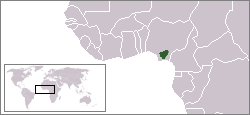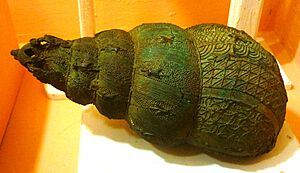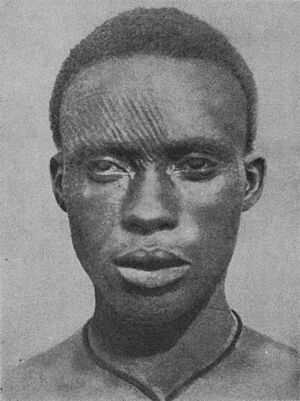Kingdom of Nri facts for kids
Quick facts for kids
Kingdom of Nri
Ọ̀ràézè Ǹrì
|
|||||||
|---|---|---|---|---|---|---|---|
| 9th century–1912 | |||||||

Nri's area of influence (green) with West Africa's modern borders
|
|||||||
| Capital | Igbo-Ukwu | ||||||
| Common languages | Igbo | ||||||
| Government | Elective monarchy | ||||||
| Sacred king | |||||||
| Ézè | |||||||
|
• 1043—1089
|
Eze Nri Ìfikuánim | ||||||
|
• 1988–present
|
Eze Nri Ènweleána II Obidiegwu Onyeso | ||||||
| History | |||||||
|
• Established
|
9th century | ||||||
|
• Surrender to the British Empire
|
1912 | ||||||
|
• Socio-political revival
|
1974 | ||||||
| Currency | Okpogho | ||||||
|
|||||||
The Kingdom of Nri (Igbo: Ọ̀ràézè Ǹrì) was an old kingdom in what is now Nigeria. It was a place of religious and political power. This kingdom influenced a large part of the Igboland area. A special priest-king called an Eze Nri led the kingdom. The Eze Nri handled trade and talks with other groups. He also had spiritual power for the Nri people. The Nri people are a part of the Igbo-speaking community.
The kingdom was a safe place for people who were not accepted elsewhere. It was also a place where enslaved people could find freedom. Nri grew by convincing nearby communities to join them. They did not use force or war.
The founder of Nri, Eri, was believed to be a "sky being." He came to Earth and started this civilization. The famous Igbo-Ukwu artifacts are important remains of the Nri culture. Nri's culture deeply affected the Northern and Western Igbo people. This was especially true through their religion and rules. The kingdom's power began to fade in the 1700s. Other kingdoms like Benin and Igala grew stronger. The Atlantic slave trade also played a role. However, Nri kept some power until the British took over in 1911. Today, it still exists as one of the traditional states in modern Nigeria.
Contents
History of the Kingdom of Nri
The Nri kingdom is located in the Igbo area of Nigeria. Nri and Aguleri are important places in the Igbo creation story. This story says that the Umu-Eri clan came from a king named Eri. Eri's beginnings are not fully clear. Some say he was a "sky being" sent by Chukwu (God). He is known for bringing order to the people of Anambra. Nri's history can be split into different time periods. These include the time before Eri, the Eri period, and times of growth and decline. There has also been a cultural revival since 1974.
How Nri Began
Some experts like Onwuejeogwu think Nri's influence started as early as the 1100s. Royal burials found there date back to at least the 800s. Other writers believe Eri, the god-like founder, settled the area around the 1500s. The first eze Nri (King of Nri), Ìfikuánim, came after him. Oral stories suggest Eri became king in 1043. However, other sources place Ìfikuánim's rule around 1225 CE.
In 1911, 19 names of eze Nri were recorded. But it's hard to put them in exact order. This is because there were long gaps between kings. Tradition said that at least seven years passed after an eze Nri died before a new one was chosen. This waiting period allowed the dead eze Nri to show his choice from beyond the grave. No matter the exact date, this time marked the start of Nri kingship as a central power.
Growth and Decline of Nri
The Kingdom of Nri grew by sending out mbùríchi, who were like special travelers or converts. These people went to other settlements. Communities joined the eze Nri not by war, but through sacred promises. The local king held religious power. The traveling mbùríchi helped keep these ties strong. By the late 1500s, Nri's influence reached far. It went beyond the northern Igbo area to communities near the Niger River. It even reached areas affected by the Benin Empire. There is also evidence of Igbo influence in Benin and Southern Igala areas before Nri arrived. At its strongest, Nri influenced about a quarter of Igboland and beyond.
Nri's power in much of northwestern and western Igboland lasted for many kings. After a while, conflicts began to appear. This was likely due to the money involved in the slave trade. The chance to make money from the slave trade was too strong. Nri's influence started to decline after the early 1700s. Yet, it continued in a smaller, weaker form until 1911. That year, British colonial troops forced the eze Nri to give up his religious power. This ended the Kingdom of Nri as a political power.
Government and Society
Most communities in Igboland had a system of titles. Igbo people west of the Niger River and on its east bank developed kingships. States like Aboh, Onitsha, and Oguta had rulers called Obi. This word Obi means "heart" in most Igbo dialects. It might refer to kingship in a symbolic way. It is not necessarily from the Oba of the Benin Empire.
The Igbo of Nri, however, had a state system based on religious power. The Kingdom of Nri was a religious state, like a theocratic government. It grew in the central part of the Igbo region. The Nri had a special set of rules called taboos. These rules covered six types of things. They included humans (like twins), animals, objects, times, behaviors, speech, and places. These rules helped teach and guide Nri's people. This meant that all followers of the Igbo religion had to follow these rules. They also had to obey the eze Nri, who was God's representative on Earth.
An important symbol in the Nri religion was the omu. This was a tender palm frond. It was used to make things sacred and to control them. It protected traveling groups or special objects. A person or object with an omu twig was considered safe. The power of these symbols and rules went far beyond Nri. This special Igbo system could control areas larger than just villages or towns.
For many centuries, people in Nri-influenced areas were committed to peace. This religious idea of peace came from a belief that violence was wrong. They thought it polluted the earth. Instead, the eze Nri could declare a type of excommunication. This was called odinani Nri. It was used against those who broke specific taboos. Members of the Ikénga could cut off entire communities using this ritual punishment.
Eze Nri - The Sacred King
The eze Nri was the title of Nri's ruler. He had ritual and spiritual power, but not military power. He was more of a religious figure than a king in the usual sense. The eze Nri was chosen after a waiting period. During this time, electors looked for signs from supernatural powers. These signs would show who the new eze Nri should be. He was crowned after a special trip to Aguleri on the Anambra River. Before this trip, authorities had to be told to get the Ududu-eze, the royal staff. There, the new Eze Nri honored all the shrines in Aguleri. He visited Menri's tomb and collected a special staff called Ofo. A pure boy helped get clay from a diver. The new Eze-Nri sat on Eri's throne in Enugwu Aguleri. Then he returned to Nri on the seventh day. He went through a symbolic burial and rising. Finally, he was covered with white clay, a sign of purity. When he died, he was buried sitting in a wooden chamber. The eze Nri was seen as a divine ruler in every way.
The Ikénga and Ndi Nri
The eze Nri lived somewhat apart from his followers. But he had a group of officials called ndi Nri. These were religious experts. You could easily spot them by their facial scarifications or ichi. They traveled with special staffs of peace. Their job was to cleanse the earth from human wrongdoings. The ndi Nri had power over large areas of Igboland. They also had the power to choose the next eze Nri.
Areas influenced by Nri were called Odinani Nri. Ndi Nri could travel freely in these areas. They performed rituals to ensure good harvests or to bring peace to local problems. Local men in the odinani Nri could represent the eze Nri. They shared his moral authority by buying special titles called Ozo and Nze. Men with these titles were known as mbùríchi. They became part of Nri's religious and political system. They controlled farming and decided who was guilty or innocent in arguments.
Both the Ndi Nri priests and mbùríchi nobility belonged to the Ikénga. This term means "the right hand." The Ìkénga god was linked to success and power. Both of these were connected to the right hand.
Economy and Trade
Nri kept its wide influence well into the 1500s. The peace that the Nri religion demanded helped trade grow. Items like horses, which could not live in Nri due to tsetse flyes, have been found in Nri bronze art. Seashells, which had to travel far from the coast, were also depicted. A Nri leader was found with ivory. This shows that Nri had a lot of wealth from trade. Another source of money came from the traveling mbùríchi.
Unlike many African economies of that time, Nri did not practice or trade in enslaved people. Some parts of the Nri area did not allow slavery. They served as safe places for those seeking freedom. After the tenth eze Nri was chosen, any enslaved person who stepped onto Nri land was considered free.
Nri had a network of trade both inside and outside its borders. Its economy partly relied on this trade. Other parts of Nri's economy were hunting and farming. Eri, the sky being, was the first to "count" the days by their names. These were eke, oye, afor, and nkwo. These were the names of their four guiding spirits. Eri showed the Igbo people how to use these days for trading goods and sharing knowledge.
Culture and Beliefs
Art of Nri

Igbo-Ukwu, a town about 18 kilometers south of Nri, was known for its bronze casting. They used elephant-head designs. The bronzes of Igbo-Ukwu are often compared to those from Ife and Benin. But they come from a different art style. They are linked to the eze Nri by Eri's descendants. In fact, the oldest Nigerian bronzes were found in Igbo land, east of the Niger River. They date back to the 800s, making them older than Ife bronzes.
It seems Nri had an artistic and religious influence on the lower Niger area. Sculptures found there are bronze, like those at Igbo-Ukwu. The great sculptures of the Benin Empire, however, were almost always made of brass. Over time, they added more zinc.
The bronzes of Igbo-Ukwu show great attention to detail. They show birds, snails, chameleons, and other parts of nature. One piece even shows a hatching bird. Other items include gourds and vessels, often with handles. The pieces are so detailed that tiny insects are on some surfaces. Others have what looks like bronze wires wrapped around them. All these details were part of the single bronze piece. Igbo-Ukwu showed that Nri had an early tradition of bronze casting.
Nri Religion
Religious beliefs were very important to the Kingdom of Nri. Nri's oral stories say that a lot of yams and cocoyams could be given to the eze Nri. In return, blessings were given. People believed that Nri's power and plenty of food came from the ruler's blessings. Most importantly, Nri was a holy land for Igbo people who followed its rules. It was a place where sins and taboos could be forgiven just by entering it.
Nri people believed the sun was where Anyanwu (Light) and Agbala (Fertility) lived. Agbala was the spirit of all holy beings, both human and nonhuman. Agbala was seen as the perfect helper of Chukwu or Chineke (the Creator God). It chose its human and nonhuman helpers only based on their goodness. It was not involved in politics. It went beyond religion, culture, and gender. It worked with humble and truthful people. They believed Anyanwu, The Light, was a symbol of human perfection that everyone should seek. Agbala was trusted to lead people there.
Nri Traditions
Nri traditions were based on peace, truth, and harmony. This idea was spread by the Ozo traders. These traders helped keep Nri's influence strong. They traveled and shared Nri practices, like the "Ikenga." These men were known by the ritual facial marks they had. Nri people believed in cleansing and purifying the earth. They saw the earth as a supernatural force called Ana and Ajana. They wanted to cleanse it of human wrongdoings and crimes.
The Year Counting Ceremony
The Igu Aro festival (counting of the year) was a royal event. The eze Nri used it to keep his power over the communities. Each community sent people to give gifts during the ceremony. This showed their loyalty. At the end, the Eze Nri would give the people a special yam medicine. He would also give a blessing of good harvests for their communities. The festival was a day of peace. Certain things were not allowed, like planting crops before the ceremony. Splitting wood and making unnecessary noise were also forbidden. Igu Aro was a regular event. It gave the eze a chance to speak directly to all the communities under him.
Nri Facial Marks
Ritual facial marks in Nri were called Ichi. There were two styles: the Nri style and the Agbaja style. In the Nri style, a carved line went from the middle of the forehead down to the chin. Another line went across the face, from the right cheek to the left. This was repeated to make a pattern that looked like the sun's rays. In the Agbaja style, circles and half-circles were added to the first cuts. These represented the moon. These marks were given to the eze Nri's representatives, the mbùríchi. The marks were Nri's way of honoring the sun they worshipped. They were also a form of spiritual cleansing.
The practice of making these marks came from Nri stories. Nri, the son of Eri who founded the town of Nri, asked Chukwu (the Great God) for help because of hunger. Chukwu told him to cut off his first son's and daughter's heads and plant them. This created a "blood bond" between the Igbo people and the earth deity, Ana. Before doing this, Nri was told to make ichi marks on their foreheads. Cocoyam, a crop grown by women, grew from his daughter's head. Yam, the main crop of the Igbo people, grew from his son's head. Chukwu had taught Nri how to grow plants. Because of this, the eze Nri's first son and daughter had to get these marks seven days after birth. The eze Nri's daughter was the only female to receive ichi. Nri, Eri's son, also learned about the yam medicine (ogwu ji). People from other Igbo communities traveled to Nri to get this knowledge. They gave yearly gifts in return.
See also
- Nri-Igbo
- Archaeology of Igbo-Ukwu
- History of Nigeria
- List of rulers of Nri
- List of Nigerian traditional states
- Nigerian traditional rulers




